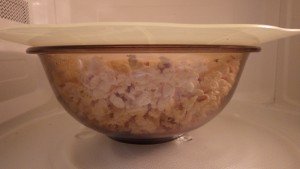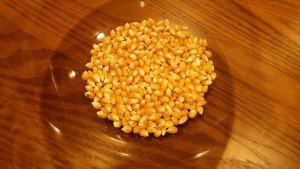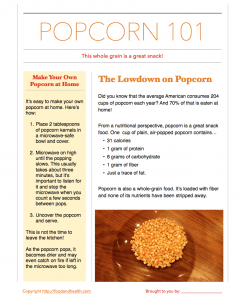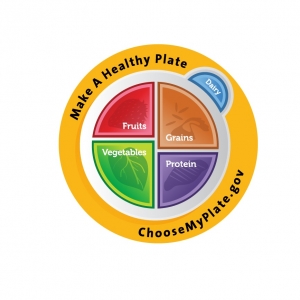Popcorn Basics
 The snack food aisle at the grocery store seems to grow every week as new items appear. I’m constantly amazed at this market -- who’s buying this stuff?? -- and I’m also stunned by the price of a bag of chips. This got me thinking about an old-fashioned snack we had as kids.Popcorn.Though it's been a treat for ages, popcorn shows no sign of going out of style. The National Popcorn Board estimates that each person in America consumes 204 cups of popcorn each year. Plus, it turns out that 70% of that number comes from popcorn eaten at home.From a nutritional perspective, popcorn can be head and shoulders above other snack foods. After all, 1 cup of plain air-popped popcorn contains just 31 calories, 1 gram of protein, 6 grams of carbohydrate, 1 gram of fiber, and just a trace of fat. Furthermore, popcorn is a whole-grain food. This means that it's loaded with fiber and none of its nutrients have been stripped away.The calories in popcorn can vary based on how it's prepared. For example, cooking popcorn in a tablespoon of oil on top of the stove can double the calories! Here are the calculations...
The snack food aisle at the grocery store seems to grow every week as new items appear. I’m constantly amazed at this market -- who’s buying this stuff?? -- and I’m also stunned by the price of a bag of chips. This got me thinking about an old-fashioned snack we had as kids.Popcorn.Though it's been a treat for ages, popcorn shows no sign of going out of style. The National Popcorn Board estimates that each person in America consumes 204 cups of popcorn each year. Plus, it turns out that 70% of that number comes from popcorn eaten at home.From a nutritional perspective, popcorn can be head and shoulders above other snack foods. After all, 1 cup of plain air-popped popcorn contains just 31 calories, 1 gram of protein, 6 grams of carbohydrate, 1 gram of fiber, and just a trace of fat. Furthermore, popcorn is a whole-grain food. This means that it's loaded with fiber and none of its nutrients have been stripped away.The calories in popcorn can vary based on how it's prepared. For example, cooking popcorn in a tablespoon of oil on top of the stove can double the calories! Here are the calculations...
- Popcorn pops to 40 times its original size.
- One ounce (2 Tbsp of kernels) makes about 4 cups of popcorn.
- Four cups of popcorn have 125 calories.
- There are 120 calories in one tablespoon of oil.
- Oil-popped popcorn, therefore, has roughly 245 calories. That's about 60 calories per cup.
Now let's look at microwave popcorn.Each kind of microwave popcorn has its own added ingredients, which almost always include fat, sodium, and sugar. In fact, these varieties have too many added ingredients, so I skip them. If you have your heart set on microwave popcorn, study the nutrition labels first and choose an option that's low in calories, solid fats, sodium, and added sugars. Making your own popcorn at home gives you control over the ingredients and can help you save money too. I calculated that those 2 tablespoons of popcorn kernels cost around 10 cents (that’s 4 cups of popped corn). Compare that to the 80 cents it costs to get the same amount of already-popped popcorn. Or compare that cost to the 33 cents it costs to get 4 cups of popped microwave popcorn.It's easy to make your own microwave popcorn without any added ingredients!Here's how I do it.
Making your own popcorn at home gives you control over the ingredients and can help you save money too. I calculated that those 2 tablespoons of popcorn kernels cost around 10 cents (that’s 4 cups of popped corn). Compare that to the 80 cents it costs to get the same amount of already-popped popcorn. Or compare that cost to the 33 cents it costs to get 4 cups of popped microwave popcorn.It's easy to make your own microwave popcorn without any added ingredients!Here's how I do it.
- Place 2 tablespoons of unpopped popcorn kernels in a microwave-safe bowl and cover.
- Microwave on high until the popping slows. This usually takes about three minutes, but it's important to listen for it and stop the microwave when you count a few seconds between pops.
- Uncover the popcorn and serve.
Now let's talk food safety.This is not the time to leave the kitchen! As the popcorn pops, it becomes drier and may even catch on fire if left in the microwave too long. Oh, and be sure to skip brown paper bags. These bags are not approved for microwave use and may not be safe for foods. Bags can easily catch fire and unknown chemicals or other materials on or in the bags may come in contact with the food.The National Popcorn Board recommends storing popcorn in a tightly closed container in a cool location. But don’t store the kernels in the refrigerator or freezer, as this may cause them to loose moisture.So get out there and get popping!By Cheryle Jones Syracuse, MS, Professor Emeritus at The Ohio State UniversityHere's a free handout with the basics about popcorn. Download it today and share it with your clients! And don't miss these great materials from the Nutrition Education Store!
And don't miss these great materials from the Nutrition Education Store!

 Remember, we're here when you want to look your very best right now.
Remember, we're here when you want to look your very best right now.

